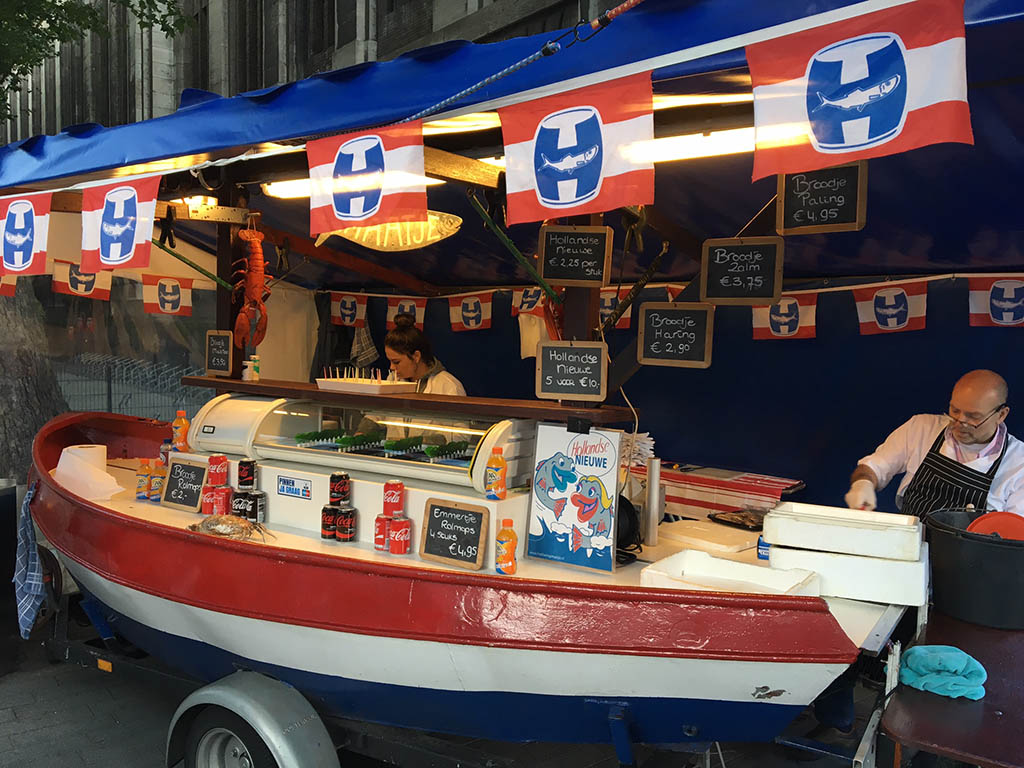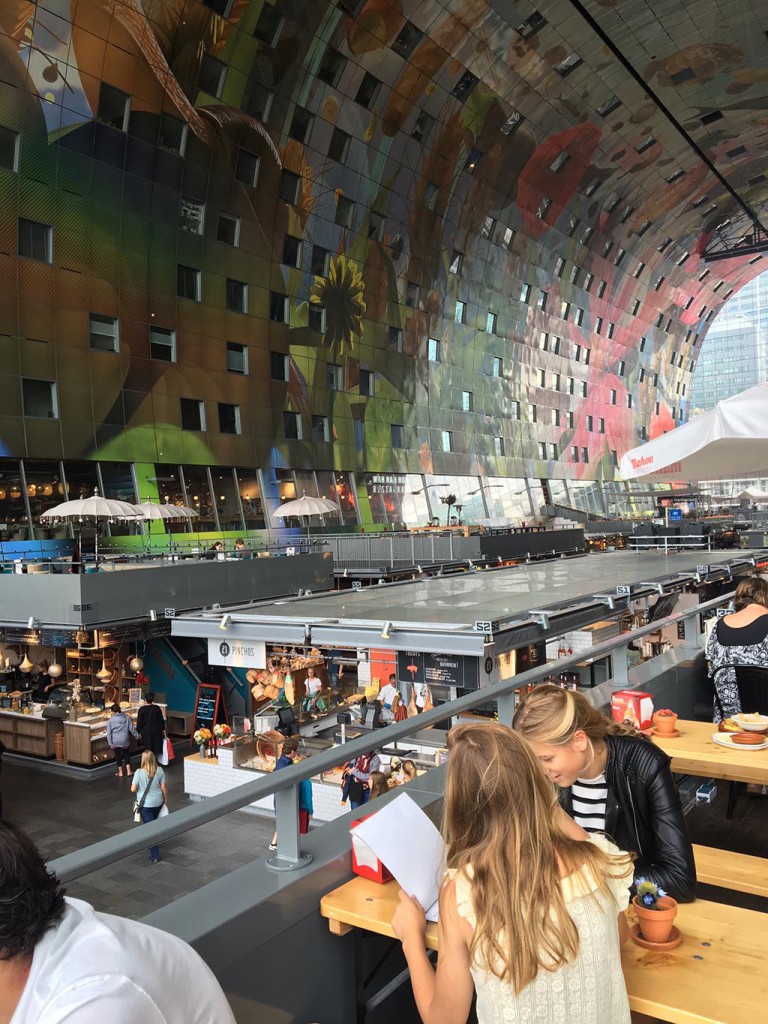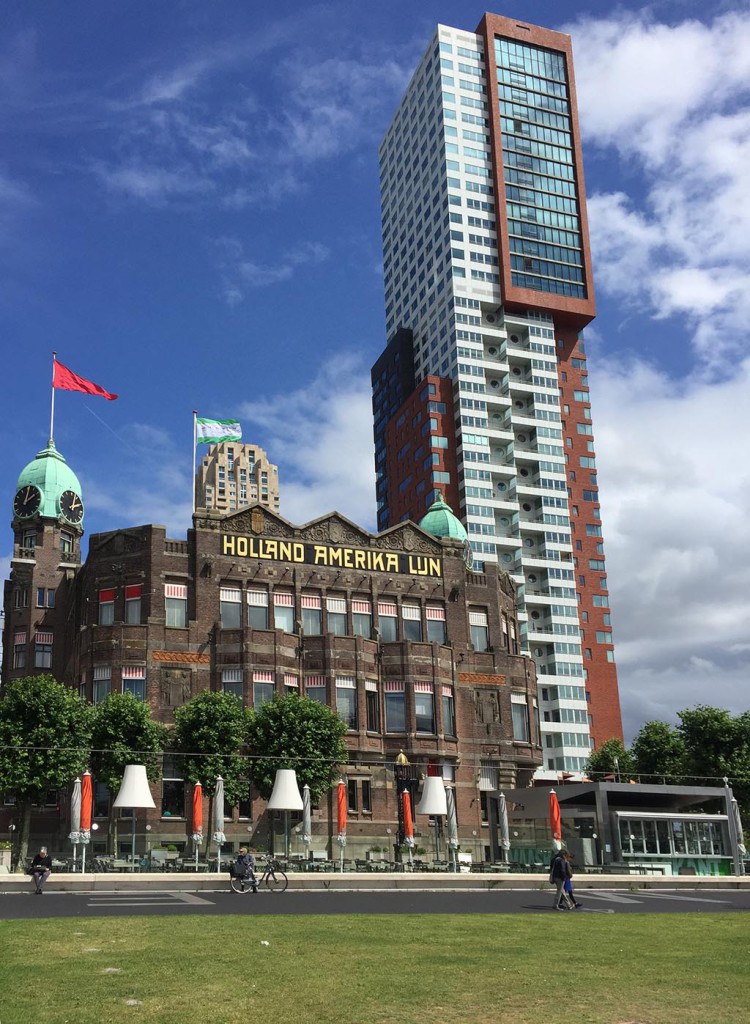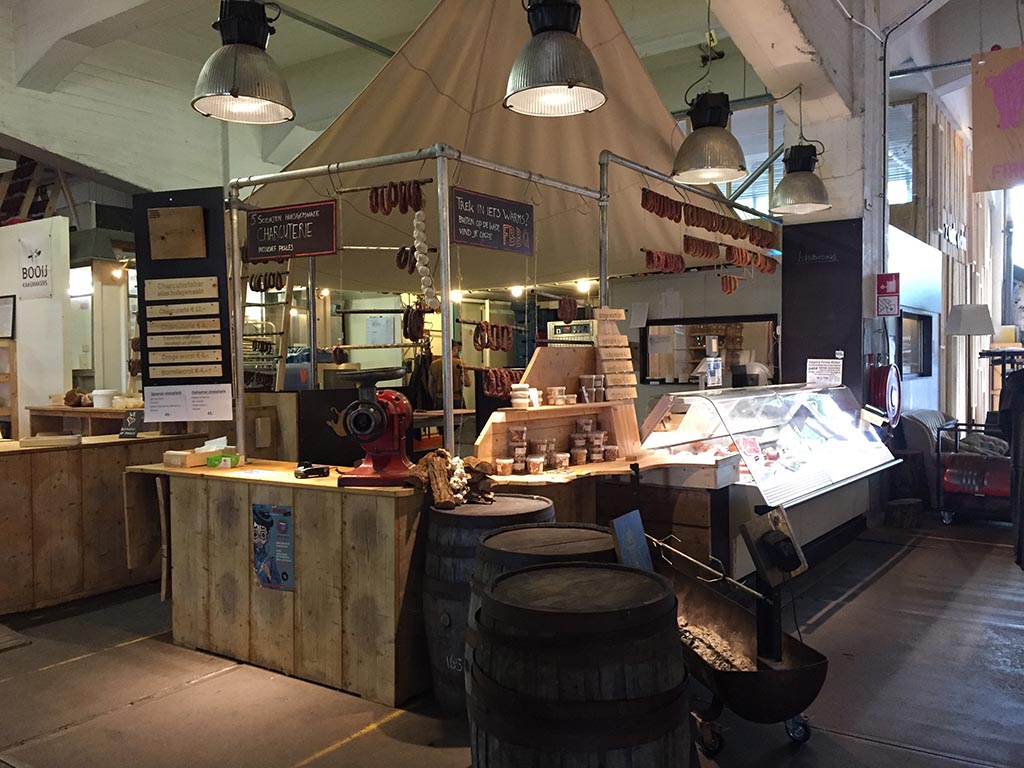This could be Rotterdam … on your first date with Hollandse nieuwe, the herrings caught in the North Sea during the months of May and June, cured-in-brine and then served simply with grounded white onion, to eat upside of taking them by the tail as taught by the historical poster.
The biggest port of Europe dedicates its finest culinary contribution to celebrate its ancestral relationship with the Sea.
Hollandse nieuwe are well exhibited in the streets, waiting right for you on folkloristic boat-shaped food stands. You can also find them in the Markthal, the brand new roofed marketplace that, since 1st of October 2014, has launched a new morphological, typological and stylistic concept of architecture. The main building, indeed, is a wide and luminous horseshoe-shaped vault where the intrados is decorated with blow-ups of fruits and flowers. The Markthal also embraces a lively mixité of functions (commercial, directional, residential, parking). Underneath the vault, the stalls of the most popular market are open seven days a week, offering the opportunity to eat-in both local products and a huge variety of imported food. Numerous international restaurants located on the ground floor embody the multicultural composition of the city (45% of the population of Rotterdam is, indeed, made up of non-European immigrants).
Street kiosk Hollandse nieuwe, Rotterdam, Meent.
Markthal, project Studio MVRDV (Winy Maas, Jacob van Rijs, Nathalie de Vries), Rotterdam, Laurenskwartier.
Worth of note the famous Dutch fries; the bintje variety of potatoes is rendered extra crispy outside and soft inside by frying them twice (in the market you can find a tantalizing spicy version). Dutch fries are sold anywhere in the city: in restaurants, fast foods, dedicated kiosks. One of these is the famous snack bar Bram Ladage (Binnenwegplein 24), refurbished by Christiaanse e Van Der Stelt in a creative pop interpretation, and it serves fries in the classic take away cone.
Reinterpretation, change and re-functionalization are the key words of Rotterdam, a city that has seen, in more than one occasion, dramatic destructions (such as the flood of 1150 or the Luftwaffe bombing in 1940) and deep transformations, majorly linked to the constant innovations in the fields of transportation and portal services.
What was found as ancient relic was recovered, what fell into disuse was revitalized, what was destroyed left space to new interpretations of architecture and urban space.
In the working-class district of Kop van Zuid (South Head), port installations of utmost importance were constructed to be afterwards demolished in the Seventies. Right here, the greatest planning talents of Rotterdam are all under the spotlight: Sir Norman Foster, Renzo Piano, Teun Koolhaas, Rem Koolhaas, Peter Wilson, Studio Mecanoo, Ben van Berkel and Caroline Bos have shown the best of their potential through architecture, bridges, public areas and urban planning. As result, there you go: a brand new “Manhattan on the Maas”!
Amongst the relics of the past, it stands out a big jugendstil building known as the Holland America Line. It is located at the end of the Wilhelminapier, wherefrom transatlantic ships to New York have departed for over a century. Abandoned in 1971, the building was recovered in 1993 and turned into the New York Hotel. This super busy and cozy lounge bar and restaurant offers the best local food: oysters, local salmon served raw, medium-rare or well-done and typical desserts like the lemon meringue pie. The main body of the bar-restaurant faces pier and is rendered particularly picturesque by the furniture, rigorously jugendstil, placed alongside the central structure – where the kitchen is located – and realized with naval material in the shape of a boat.
Hotel New York, renovation of the nineteenth century building Holland-Amerika lijn, Rotterdam, Wilhelminapier.
The same ancestral “scent of a port” can still be smelled in Katendrecht, a harbor neighborhood that was still pretty rough up to 10 years ago. Here, the indoor food court of the Fenix Food Factory was realized inside the old warehouse Fenixloods. In the Fenix, a project achieved thanks to the initiative of seven joint food entrepreneurs of Rotterdam, everything is truly possible and within everyone’s reach. There is so much to see, to taste and to buy that you’ll be spoilt for choices. For example, you can taste many – but seriously many – varieties of craft beer, or eat local cheeses available from early to late stage of ripening. Not to mention the abundance of bakery products, the possibility to do some serious cider sampling, the diversity of green vegetables and products from local farms, the abundance of yummy burgers (compulsorily served with Dutch fries). Or even the offer of cured meats tasting, the coffee-shop for an enjoyable break, the book-store with plenty of good books or the little boutiques where purchasing furniture and modern antiques.
The atmosphere, a mixture of bohemian, vintage and hipster, is cozy and warm: in the middle of the grand loft there are chairs, armchairs, tables, stools – all of them lovely unpaired – voluptuously offered to customers to indulge them to tempting moments of relax or to favor exciting rendezvous.
Food court Fenix Food Factory, Rotterdam, Katendrecht.
The Fenix reveals the personality of Rotterdam, relaxed yet creative, undoubtedly a melting pot, capriciously dynamic: a Battle-Khaki personality, but with red underwear [1] !
English translation by Ester Badami
Notes
[1] Rotterdam or anywhere, The Beautiful South, 1996.
Head image: Historical poster Hollandse nieuwe (redesign).
This could be Rotterdam or anywhere
Potresti trovarti a Rotterdam al tuo primo appuntamento con le Hollandse nieuwe, le aringhe pescate nel Mare del Nord tra maggio e giugno, lasciate maturare in salamoia e servite semplicemente con cipolla bianca tritata. È il delicatissimo contributo culinario che il più grande porto d’Europa dedica per celebrare il suo rapporto ancestrale con il mare, da mangiare a testa in su prendendole per la coda come insegna la storica locandina.
Puoi trovarle per strada dove ti aspettano sin dal primo mattino in folkloristici banchi ambulanti di street food a foggia di barca, oppure dentro il Markthal, il nuovo grande mercato coperto che inaugura dal primo ottobre 2014 un nuova concezione morfologica, tipologica e stilistica dell’architettura: l’edificio è un’ampia e luminosa volta a forma di ferro di cavallo decorata nell’intradosso con gigantografie di frutti e fiori ed accoglie al suo interno una vivace mixité di funzioni (commerciali, direzionali, residenziali, parcheggi auto). Sotto la volta si aprono sette giorni su sette i banchi del frequentatissimo mercato che offrono anche la possibilità di mangiare sul posto sia i prodotti locali, sia una notevole varietà di cibi importati; i numerosi ristoranti di svariate nazionalità aperti ai piani terra restituiscono la composizione multiculturale della città (il 45% della popolazione di Rotterdam è costituita da immigrati non europei).
Chiosco ambulante di Hollandse nieuwe, Rotterdam, Meent.
Markthal, progetto Studio MVRDV (Winy Maas, Jacob van Rijs, Nathalie de Vries), Rotterdam, Laurenskwartier.
Non mancano anche le celeberrime patatine fritte olandesi, la varietà bintje resa croccante all’esterno e morbida all’interno grazie al metodo della doppia frittura (nel mercato se ne può gustare una apprezzabilissima variante speziata), presenti ovunque in città nei ristoranti, fast food e chioschi dedicati, come lo snack bar Bram Ladage (Binnenwegplein 24) ristrutturato da Christiaanse e Van Der Stelt in una fantasiosa interpretazione pop che le serve nel classico cono d’asporto.
Reinterpretazione, cambiamento, rifunzionalizzazione sono le parole chiave di Rotterdam, una città attraversata più volte da drammatiche distruzioni (dalle inondazioni del 1150 ai bombardamenti della Luftwaffe del 1940) e da profonde trasformazioni connesse alle costanti innovazioni nel settore dei trasporti e dei servizi portuali.
Ciò che è rimasto come reperto del passato è stato recuperato, ciò che è stato dismesso è stato rivitalizzato, ciò che è stato distrutto lascia il posto a nuove interpretazioni dell’architettura e dello spazio urbano.
A Kop van Zuid (testa del sud), quartiere operaio dove insistevano le principali installazioni portuali dismesse dagli anni ‘70, le grandi capacità progettuali di Rotterdam sono tutte in evidenza: sir Norman Foster, Renzo Piano, Teun Koolhaas, Rem Koolhaas, Peter Wilson, Studio Mecanoo, Ben van Berkel e Caroline Bos hanno dato il meglio di sé tra architetture, ponti, spazi pubblici e piani urbanistici costruendo una nuova “Manhattan on the Maas”.
Tra i reperti del passato il grande edificio jugendstil della Holland America Line in fondo al Wilhelminapier, dal quale per un secolo sono salpate le navi dirette a New York e dismesso nel 1971, è stato rifunzionalizzato dal 1993 nell’Hotel New York che contiene un albergo, un american bar e un cozy restaurant – sempre affollatissimo – che serve il meglio dei prodotti locali: oyster bar, salmone locale in tutte le varianti di cottura, dessert tipici come la lemon meringue pie. Il grande ambiente del bar-ristorante, svetrato e affacciato sul molo, è reso particolarmente suggestivo dagli arredi jugendstil che circondano la struttura centrale – dove sono ospitate le cucine – realizzata con le forme e i materiali di una nave.
Hotel New York, ristrutturazione dell’edificio ottocentesco Holland-Amerika lijn, Rotterdam, Wilhelminapier.
Lo stesso sapore di “porto” si sente ancora a Katendrecht, quartiere portuale fino a 10 anni fa molto malfamato, dove nell’ex magazzino del Fenixloods è stata realizzata la food court coperta del Fenix Food Factory. All’interno del Fenix, grazie all’iniziativa di sette food entrepreneurs di Rotterdam, tutto è possibile ed alla portata delle disponibilità di ciascuno: degustare molte – davvero molte – varietà di birra alla spina di una birreria artigianale, mangiare i formaggi locali in tutti i loro stadi di stagionatura, comprare prodotti da forno, degustare del sidro, acquistare le verdure e i prodotti di una fattoria locale, mangiare un buon hamburger con patatine fritte ‘olandesi’, degustare salumi, prendere il caffè, trovare un buon libro da leggere, acquistare mobili e complementi d’arredo di modernariato. L’atmosfera, un misto di bohémien, vintage e hipster, è calda e accogliente; al centro del grande loft sedie, poltrone, tavoli, sgabelli – tutti rigorosamente spaiati – sono a disposizione degli avventori, suggerendo momenti di relax informale o favorendo eccitanti incontri.
Food court del Fenix Food Factory, Rotterdam, Katendrecht.
Al Fenix scopri la personalità di Rotterdam, rilassata ma creativa, decisamente melting pot, estrosamente dinamica: una Battle–khaki personality, ma with red underwear[1] !
Note
[1] Rotterdam or anywhere, The Beautiful South, 1996.
Head image: Locandina storica delle Hollandse nieuwe (elaborazione grafica).



